~~~~~~~~~~~~~~~~~~~~~~~~~~~~~~~~~~~~~~~~~~~~~~~~~~~~~~~
MEMBERSHIP DRIVE
If you’ve been enjoying our Photo of the Week, please consider becoming a member of SCHS.
From the Civil War to civil rights, revolutions to restorations, spies to Suffragettes, boatbuilders to bootleggers, and whalers to wineries, Long Island’s history comes alive at the Suffolk County Historical Society!
The Suffolk County Historical Society, founded in 1886, collects and preserves the rich history of Suffolk County and beyond. We offer a history museum, art galleries, a research library and archives, and a multitude of exhibits, programs, and educational lectures and workshops year-round. Our unique collections reflect more than three centuries of Long Island history. Click here to learn about Member Benefits!
——————–
Interested in seeing more historical photos from the Collection of the Suffolk County Historical Society? Spend an afternoon at our Local History Library perusing our extensive archival photography collections. We’re open Weds. – Sat., 12:30 – 4:30 PM.
~~~~~~~~~~~~~~~~~~~~~~~~~~~~~~~~~~~~~~~~~~~~
PHOTO OF THE WEEK: DECEMBER 23, 2016 — FROM THE SCHS LIBRARY ARCHIVES
“How shall we know it is us without our past?” – John Steinbeck
~~~~~~~~~~~~~~~~~~~~~~~~~~~~~~~~~~~~~~~~~~~~~~~~~~~~~
HOLIDAY GREETINGS!

Assorted Holiday Cards From the 1-Cent Postcard Era of the Early 1900s.
The Staff and Board of the
Suffolk County Historical Society
send warm wishes to all of our
friends and supporters
for a wonderful holiday season
and a very happy new year!
Holiday Closure: We will be closed December 24-31, and will reopen on Weds., Jan. 4, 2017.
(Image from the Postcard Collection of the Suffolk County Historical Society Library Archives.)
************************************************************
SCHS Photo of the Week: Click Here to Visit Webpage.
Visit: www.suffolkcountyhistoricalsociety.org
To view 2014 Photo of the Week pages click here.
To view 2015 Photo of the Week pages click here.
~~~~~~~~~~~~~~~~~~~~~
PHOTO OF THE WEEK: DECEMBER 17, 2016 — FROM THE SCHS LIBRARY ARCHIVES
“How shall we know it is us without our past?” – John Steinbeck
Long Island Rail Road “Firsts”
by Wendy Polhemus-Annibell, Librarian

LIRR Diesel Locomotive, 1926. (Image from the Collection of the Suffolk County Historical Society Library Archives.)
Old No. 401 was the “granddaddy” of all diesel locomotives, shown here on one of its LIRR experimental runs in 1926. Throughout the early history of the Long Island Rail Road, beginning in the 1830s, the company was a pioneer in American railroading, chaulking up an impressive list of historic national “firsts”:
First to use the hook-headed track spike (1836).
First to install a steam whistle on a locomotive (1836).
First to use “piggy-back”–hauling farm wagons on flat cars (1885).
First to use an all-steel passenger car (1905) and to have an all-steel passenger car fleet (1927).
First to install extensive main line electrification (1905).
First to use a diesel locomotive in road service (1926).
First to use modern mercury-arc rectifiers to supply third-rail current (1926).
First to install completely remote-controlled electrical substations (1930).
First to use a fully automatic high-speed control system (1951).
Suggested Reading: Long Island Rail Road Co., Long Island’s Main Line to the Mainland, 1959.
———————————————————————-
 Last Chance to View! Historic Reflections of the Ten Towns
Last Chance to View! Historic Reflections of the Ten Towns
On display now thru December 23 in our Weathervane Gallery!
************************************************************
SCHS Photo of the Week: Click Here to Visit Webpage.
Visit: www.suffolkcountyhistoricalsociety.org
To view 2014 Photo of the Week pages click here.
To view 2015 Photo of the Week pages click here.
~~~~~~~~~~~~~~~~~~~~~~~~~~~~~~~~~
PHOTO OF THE WEEK: DECEMBER 10, 2016 — FROM THE SCHS LIBRARY ARCHIVES
“How shall we know it is us without our past?” – John Steinbeck
Camp Upton Public Auction Sale Book, c. 1921
by Wendy Polhemus-Annibell, Librarian
 Camp Upton Public Auction Sale Book, c. 1921 (Image from the Collection of the Suffolk County Historical Society Library Archives. Copyright © Suffolk County Historical Society. All rights reserved.)
Camp Upton Public Auction Sale Book, c. 1921 (Image from the Collection of the Suffolk County Historical Society Library Archives. Copyright © Suffolk County Historical Society. All rights reserved.)
Over 1600 items were listed for auction in this 122-page Camp Upton “Public Auction Sale” book. Generally categorized as “buildings, utilities, and improvements,” the itemized materials included everything but the kitchen sink! Listed were such large items as entire barracks, selected “corridors,” dormitories, sheds and garages, mess halls, and an ice-cream shack. Also up for auction were sewer systems, galvanized iron pipes, heating furnaces, porcelain toilet bowls, and three ironing boards. The auction book, available in our library archive, is a lasting window into the 1920s physical inventory of the historic Army camp.
Camp Upton was named after Emory Upton, a Union general in the Civil War. Located near Yaphank in the heart of the Pine Barrens, Camp Upton was built in 1917 as an induction and training facility for tens of thousands of soldiers who went on to fight in World War I. Between the world wars, the camp was used by members of the Civilian Conservation Corps, who planted many of the trees on the site. Then in 1940, on the eve of World War II, Camp Upton was reopened to serve its original purpose as a military training ground. In 1944, the site was used as a hospital to treat wounded veterans of the war. It also served as a prisoner of war camp, when in 1945, five hundred German prisoners were sent to Camp Upton. In 1947, the camp was replaced by Brookhaven National Laboratory.
************************************************************
SCHS Photo of the Week: Click Here to Visit Webpage.
Visit: www.suffolkcountyhistoricalsociety.org
To view 2014 Photo of the Week pages click here.
To view 2015 Photo of the Week pages click here.
~~~~~~~~~~~~~~~~~~~~~~~~~~~~~~~~~
PHOTO OF THE WEEK: November 24, 2016 — FROM THE SCHS LIBRARY ARCHIVES
“How shall we know it is us without our past?” – John Steinbeck
Saltaire Advertisement, 1913
by Wendy Polhemus-Annibell, Librarian

Saltaire Advertisement, 1913 (Image from the Collection of the Suffolk County Historical Society Library Archives. Copyright © Suffolk County Historical Society. All rights reserved.)
Saltaire, whose name was not derived from the salty sea air but from an English town on the River Aire named for Lord Salt, got its start in 1910 when the Fire Island Beach Development Corporation purchased land from the Glahn family in 1910. The corporation advertised heavily in NYC in order to bring potential home buyers to the island for free on its private ferries. The boats left Bay Shore in the morning and returned at 5:00 pm, or visitors could spend the night in one of the six guest houses put up by the promoters and attend discussions. In 1913, the corporation placed the ad pictured here in a Long Island Railroad publication; “Remember, you can own a home in Saltaire at a price and on terms that are within your reach: Bungalows with plot, $1800 and up.”
By 1911, one hundred homes had been built in Saltaire, and by 1912 the community had a homeowner’s association and a yacht club. The first on Fire Island to incorporate, the community became the “Incorporated Village of Saltaire” in 1917. A post office was opened in 1924, and electricity was introduced in 1936. After a period of considerable growth in the 1950s, however, the zoning laws were amended in 1965 to limit the maximum number of homes in Saltaire to 470, rather than the original one thousand homes orginally planned.
Suggested Reading: Fire Island: 1650s-1980s, by Madeleine C. Johnson (Shoreland Press, 1983).
************************************************************
SCHS Photo of the Week: Click Here to Visit Webpage.
Visit: www.suffolkcountyhistoricalsociety.org
To view 2014 Photo of the Week pages click here.
To view 2015 Photo of the Week pages click here.
~~~~~~~~~~~~~~~~~~~~~~~~~~~~~~~~~~
PHOTO OF THE WEEK: November 24, 2016 — FROM THE SCHS LIBRARY ARCHIVES
“How shall we know it is us without our past?” – John Steinbeck
Thanksgiving Greetings
by Wendy Polhemus-Annibell, Librarian
Thanksgiving Greetings, 1909. (Image from the Postcard Collection of the Suffolk County Historical Society Library Archives. Copyright (c) Suffolk County Historical Society. All rights reserved.) These particular postcards, sent in 1909 from Florida and Connecticut, were addressed to “Mr. S.H. Miller, Miller’s Place, Suffolk County, N.Y.”
The Suffolk County Historical Society’s staff and board send our warmest wishes to you and your family for a wonderful Thanksgiving holiday.
Holiday Closure: We will be closed November 24-26 and will reopen on Wednesday, November 30.
************************************************************
SCHS Photo of the Week: Click Here to Visit Webpage.
Visit: www.suffolkcountyhistoricalsociety.org
To view 2014 Photo of the Week pages click here.
To view 2015 Photo of the Week pages click here.
~~~~~~~~~~~~~~~~~~~~~~~~~~~~~~~~~~
PHOTO OF THE WEEK: November 19, 2016 — FROM THE SCHS LIBRARY ARCHIVES
“How shall we know it is us without our past?” – John Steinbeck
Hunters Garden Association of Suffolk County
by Wendy Polhemus-Annibell, Librarian
Hunters Garden Association of Suffolk County, c. 1883. (Image from the Postcard Collection of the Suffolk County Historical Society Library Archives. Copyright (c) Suffolk County Historical Society. All rights reserved.)
The Hunters Garden Association was organized in 1833 with Wells Tuttle chosen as the first president. It was incorporated in 1891 with the purpose of “promoting social interaction among the inhabitants of the County of Suffolk and to assist in the enforcement of all game laws and the preservation of game and fish.”
The association was also founded on the traditions of the “Great Hunter” John Tuttle (1728-1805), Wells Tuttle’s grandfather, who came from Southold and was one of the first settlers of Speonk before 1760. John Tuttle and his two sons would ride horseback to the big annual hunt held in the fall when all the farm work had been completed. After the hunt, they roasted deer and prepared a bountiful meal. They also talked about local happenings, their cattle and grain, and their children and grandchildren. After John Tuttle died, his sons and grandson carried on the tradition.
Wells Tuttle (1803-1887) had the initial idea to establish a garden in the woods, where association members would gather twice a year (in May and October) for Hunters Garden Day to have dinner and plant and/or gather their garden’s crops. It was also thought that the garden would attract the deer from surrounding areas. A spot on the Quogue plains between Eastport and Riverhead was thereafter cleared and planted with potatoes, beans, watermelon, and tomatoes. This place became known as the Hunters Garden. In 1874 the group moved to a different area in the same vicinity, where at the twice yearly meetings members carried on the traditions of dining on eel chowder, bass and bluefish chowder, and clams and oysters. Eighty members attended the feast in 1877, at which point the annual membership fee increased from 25 cents to 50 cents. In 1880 the garden was moved to a property near Eastport called Brewster’s Lots, which provided a better water supply for the Hunters Garden. When in 1924 the road to Brewster’s Lots became temporarily impassable, the group met for two years in the grove of Henry Hallock on Sound Avenue in Riverhead.
Hunters Garden members from the north and south sides eventually split. Members from the north side began using two acres on Great Pond (Wildwood Lake) for meetings, where Hudson Griffin of Riverhead had built a clubhouse for members’ use.
Suggested Reading: “The Hunters Garden Association,” by Samuel Cross, Long Island Forum, May 1977.
************************************************************
SCHS Photo of the Week: Click Here to Visit Webpage.
Visit: www.suffolkcountyhistoricalsociety.org
To view 2014 Photo of the Week pages click here.
To view 2015 Photo of the Week pages click here.
—————————
MEMBERSHIP DRIVE
If you’ve been enjoying our Photo of the Week, please consider becoming a member of SCHS.
From the Civil War to civil rights, revolutions to restorations, spies to Suffragettes, boatbuilders to bootleggers, and whalers to wineries, Long Island’s history comes alive at the Suffolk County Historical Society!
The Suffolk County Historical Society, founded in 1886, collects and preserves the rich history of Suffolk County and beyond. We offer a history museum, art galleries, a research library and archives, and a multitude of exhibits, programs, and educational lectures and workshops year-round. Our unique collections reflect more than three centuries of Long Island history. Click here to learn about Member Benefits!

~~~~~~~~~~~~~~~~~~~~~~~~~~~~~~~~~~~~~~~~~~~~~~~~~~~~~~~~~~~
PHOTO OF THE WEEK: November 11, 2016 — FROM THE SCHS LIBRARY ARCHIVES
“How shall we know it is us without our past?” – John Steinbeck
~~~~~~~~~~~~~~~~~~
Great Gull Island, Town of Southold
by Wendy Polhemus-Annibell, Librarian
Great Gull Island of Southold Town. (Image from the Map Collection of the Suffolk County Historical Society Library Archives. Copyright (c) Suffolk County Historical Society. All rights reserved.)
Great Gull Island, a 17-acre island just 2.5 miles east of Plum Island, lies within the boundaries of Southold Town. Beginning in 1886, Great Gull Island was home to Fort Michie, a coastal defense fort named after Lieutenant Dennis M. Michie of the 7th U.S. Infantry of the U.S. Army. The fort began as a 30-man post, but by the start of World War I, 135 soldiers were stationed on the island. Also during the first world war, a very large disappearing 16-inch M1919 coastal defense gun was placed within a below-ground construction on the eastern tip of Great Gull Island. The gun was designed so that it could be lowered into the ground and thus remain out of sight when not in use. On its first test firing, the gun reportedly blew out the windows of residents in Southold and Connecticut. Today, the military fort’s ruins, including the 16-inch gun’s foundation, can be viewed in fascinating images on Google Earth.

In 1949, the federal government (through the War Assessment Administration) set about to auction off Great Gull Island to the highest bidder. After collecting bids, however, the government decided instead to award the island to the American Museum of Natural History for use as a sanctuary for terns (which it remains today). The museum acquired the island at a “100 percent discount”–the federal government’s way of saying for free — and the museum’s $15,000 bid was refunded. Great Gull Island had long been a breeding ground for terns even before it became a coastal fort. In fact, its name — Great “Gull” Island — came about only because the terns, from a distance, were mistaken for gulls!
Suggested Reading: A World Unto Itself: The Remarkable History of Plum Island, New York, by Ruth Ann Bramson, Geoffrey K. Fleming, and Amy K. Folk (2014).
***********************************************************
On Veterans Day,
let us remember and honor the service and sacrifices of our veterans.
************************************************************
SCHS Photo of the Week: Click Here to Visit Webpage.
Visit: www.suffolkcountyhistoricalsociety.org
To view 2014 Photo of the Week pages click here.
To view 2015 Photo of the Week pages click here.
~~~~~~~~~~~~~~~~~~~~~~~~~~~~~~~~~~
PHOTO OF THE WEEK: November 5, 2016 — FROM THE SCHS LIBRARY ARCHIVES
“How shall we know it is us without our past?” – John Steinbeck
~~~~~~~~~~~~~~~~~~
Caroline Episcopal Church, Setauket
by Wendy Polhemus-Annibell, Librarian
Caroline Episcopal Church, Setauket. (Image from the Collection of the Suffolk County Historical Society Library Archives. Copyright (c) Suffolk County Historical Society. All rights reserved.)
Caroline Church was erected in Setauket in 1729 and is the oldest Episcopal church on Long Island. The construction of this simple yet beautiful colonial church was the product of an effort that lasted more than a decade. The strong royalist convictions of the early congregation are reflected in the decision to name the church in honor of England’s Queen Caroline, wife of King George II: “the church and parish shall in honour of our gracious Queen, her most serene Brittanic majesty be hereafter called Caroline Parish and Caroline Church.” A letter to Queen Caroline from the parish expressing loyalty to the Church of England resulted in a royal bequest of various church furnishings. Of the gifts sent by the queen, three remain: a chalice, paten, and alms bason.
On August 22, 1777, Revolutionary War combatants in the “Battle of Setauket” were taken up the hill to Caroline Church, where they found shelter from the heat in the nearly 50-year-old building. Holes in the church’s bell tower are believed to be bullet marks from the revolutionary battle.
The historic church was added to the National Register of Historic Places in 1991.
Suggested Reading: Caroline Church of Brookhaven, Setauket, New York, 1979.
———————————————————-
 A call for Long Island-related World War I exhibit memorabilia!
A call for Long Island-related World War I exhibit memorabilia!
~~~~~~~~~~`
In 2017, to commemorate the centennial of the American participation in World War I, the Suffolk County Historical Society Museum will present a major WWI exhibition exploring the Long Island experience during the conflict, both at home and overseas. The Society is looking for loans of materials relating to Long Island and the Great War – photographs, posters, documents, artifacts, etc.- for the exhibition. Please call 631-727-2881.
Thank you!
————————
SCHS Photo of the Week: Click Here to Visit Webpage.
Visit: www.suffolkcountyhistoricalsociety.org
To view 2014 Photo of the Week pages click here.
To view 2015 Photo of the Week pages click here.
~~~~~~~~~~~~~~~~~~~~~~~~~~~~~~~~~~
PHOTO OF THE WEEK: October 29, 2016 — FROM THE SCHS LIBRARY ARCHIVES
“How shall we know it is us without our past?” – John Steinbeck
In the Season of the Witch:
A Trial in East Hampton, 1650s
by Wendy Polhemus-Annibell, Librarian

Halloween Witch Postcard, Early 1900s. (From the Collection of the Suffolk County Historical Society Library Archives. Image copyright © Suffolk County Historical Society. All rights reserved.)
Decades before the Salem witch trials, an eastern Long Island woman was accused and tried for being a witch. The story of this 17th-century East Hampton woman tried for witchcraft takes up several pages in the East Hampton Town records, which also catalog assorted other accusations of supernatural deeds against her. Elizabeth “Goody” Garlick was married to East Hampton farmer Joshua Garlick, who had once worked for Lion Gardiner, a prominent citizen of the town. While in her 50s, Goody Garlick was charged with “bewitching” the 16-year-old daughter of Lion Gardiner, Elizabeth Howell, who had died after bearing a child and in a state of hysteria, screaming that she was killed by a witch. Colonial laws against witchcraft called for the death penalty by hanging.
“Elizabeth Garlick, thou art indicted by the name of Elizabeth Garlick the wife of Johshua Garlick of East Hampton, that not having the fear of God before thine eyes thou hast entertained Satan, the Great Enemy of God and mankind, and by his help since the year 1650 hath done works above the course of nature to the loss of lives of several persons (with several other sorceries) and in particular the wife of Arthur Howell…for which, according to the laws of God and the established law of this Commonwealth, thou deservest to die.”
In 1658, the case was moved from the East Hampton court to a higher court, the Particular Court of Connecticut in Hartford, where it was heard by seven magistrates, including Conn. Governor John Winthrop, and a jury of twelve men. The criteria for conviction in colonial times included testimony that the accused “witch” had appeared to the afflicted person in his or her fits, and that the afflicted person was able to identify by name and describe the actions of the suspected witch. As it turned out, the court was unable to find sufficient evidence to convict Goody Garlick of witchcraft, but she was not fully acquitted either. The court required that Joshua Garlick post a large bond to assure his wife’s good behavior, and Goody Garlick was required to appear periodically before the East Hampton or Connecticut.
Suggested Reading: Hugh King and Loretta Orion, “Witchcraft in the Founding Days of East Hampton,” in Awakening the Past, edited by Tom Twomey (New York: Newmarket Press, 1999).
~~~~~~~~~~~~~~~~~~~~~~~~~~~~~~~~~~~~~~~~~~~~~~~~~~

A call for Long Island-related World War I exhibit memorabilia!
In 2017, to commemorate the centennial of the American participation in World War I, the Suffolk County Historical Society Museum is preparing a major WWI exhibition exploring the Long Island experience during the conflict, both at home and overseas. The Society is looking for loans of materials relating to Long Island and the Great War – photographs, posters, documents, artifacts, etc.- for the exhibition. Please call 631-727-2881. Thank you!
———————————
SCHS Photo of the Week: Click Here to Visit Webpage.
Visit: www.suffolkcountyhistoricalsociety.org
To view 2014 Photo of the Week pages click here.
To view 2015 Photo of the Week pages click here.
~~~~~~~~~~~~~~~~~~~~~~~~~~~~~~~~~~
PHOTO OF THE WEEK: October 22, 2016 — FROM THE SCHS LIBRARY ARCHIVES
“How shall we know it is us without our past?” – John Steinbeck
The Parry Sisters of Riverhead, c. 1910
by Wendy Polhemus-Annibell, Librarian

The Parry Sisters of Riverhead, c. 1910. (From the Collection of the Suffolk County Historical Society Library Archives. Image copyright © Suffolk County Historical Society. All rights reserved.)
Pictured here are Etheyle and Jaunita Parry of Riverhead, daughters of Amy Rothermel Parry and veterinarian Archer E. Parry. Born in Riverhead in 1890 and 1891, respectively, Etheyle and Juanita became known as the Cossack Girls because they performed daring feats of horsemanship attributed to the Russian Cossack cavalry. The sisters performed with Buffalo Bill’s Wild West shows and fascinated audiences from New York to London. They also appeared in Miller Bros. shows and in the Barnum & Bailey Circus. One of their roping and riding routines involved a runaway stagecoach: Etheyle would leap off a vehicle onto a horse running alongside the stage, and Juanita would rope a fixed object from the driver’s seat of the stage to bring the team of horses to an abrupt stop.
The Parry sisters’ act lasted from 1907 to 1918, when, sadly, Juanita died after falling off her horse and breaking her neck at a Barnum & Bailey show. Etheyle married William Cody Bradford, a nephew of Buffalo Bill.
~~~~~~~~~~~~~~~~~~~~~~~~~~~~~~~~~~~~~~~~~~~~~~
A call for Long Island-related World War I exhibit memorabilia!
In 2017, to commemorate the centennial of the American participation in World War I, the Suffolk County Historical Society Museum is preparing a major WWI exhibition exploring the Long Island experience during the conflict, both at home and overseas. The Society is looking for loans of materials relating to Long Island and the Great War – photographs, posters, documents, artifacts, etc.- for the exhibition. Please call 631-727-2881. Thank you!
~~~~~~~~~~~~~~~~~~~~~~~~~~~~~~~~~~~~~~~~~~~~~~~~~~~~~~
—————————————————-
SCHS Photo of the Week: Click Here to Visit Webpage.
Visit: www.suffolkcountyhistoricalsociety.org
To view 2014 Photo of the Week pages click here.
To view 2015 Photo of the Week pages click here.
~~~~~~~~~~~~~~~~~~~~~~~~~~~~~~~~~~
PHOTO OF THE WEEK: October 14, 2016 — FROM THE SCHS LIBRARY ARCHIVES
“How shall we know it is us without our past?” – John Steinbeck
The Beers Atlas of Long Island, 1873
by Wendy Polhemus-Annibell, Librarian
The Beers Atlas of Long Island, New York, 1873. This page from the atlas includes maps of Bellport, East Moriches, Moriches, and Manorville.(From the Collection of the Suffolk County Historical Society Library Archives. Image copyright (c) Suffolk County Historical Society. All rights reserved.)
Frederick W. Beers (1858-1929) continued the work of his father, James Botsford Beers, and was known for his survey maps of New York, Ohio, Pennsylvania, Michigan, Connecticut, and Vermont. During the late nineteenth century, Frederick Beers published very detailed maps of Suffolk County, its ten towns, and its many hamlets and villages in Atlas of Long Island, New York, From Recent Actual Surveys and Records. Under the Superintendence of F.W. Beers. These maps date from the 1870s and include the names and locations of residents and businesses as well as the locations of schools, churches, cemeteries, and other landmarks. Some maps also include statistical information, engravings of key businesses, town histories, and biographies of prominent citizens, making the surveys especially valuable to historians and genealogists. The original Long Island atlas can be found in our research library.
Along with numerous other historic maps, a number of the Beers maps are currently on view in our Gish Gallery. Mapping Suffolk County, an exhibit featuring various types of historic maps, will run to the end of the year.
——————————————-
SCHS Photo of the Week: Click Here to Visit Webpage.
Visit: www.suffolkcountyhistoricalsociety.org
To view 2014 Photo of the Week pages click here.
To view 2015 Photo of the Week pages click here.
~~~~~~~~~~~~~~~~~~~~~~~~~~~~~~~~~~
PHOTO OF THE WEEK: October 8, 2016 — FROM THE SCHS LIBRARY ARCHIVES
“How shall we know it is us without our past?” – John Steinbeck
“Farm to Family — Fresh”: The LI Home Hamper, 1908
by Wendy Polhemus-Annibell, Librarian

From Farm to Family: The Long Island Home Hamper, 1908. (Image from the Collection of the Suffolk County Historical Society Library Archives. Copyright © Suffolk County HIstorical Society. All rights reserved.)
To market produce grown in the early 1900s at the LIRR experimental farms in Medford and Wading River, Hal B. Fullerton devised an early form of the modern CSA called Long Island Home Hampers, specially designed crates containing baskets of fresh produce. The crates were packed at the farms with freshly picked seasonal vegetables and fruits, and shipped by the railroad directly to consumers in the city. The Home Hamper eliminated the intervention of a merchant in the sales and distribution process and made fresh produce more affordable for middle-class urban residents. Fullerton promoted the Home Hamper as an innovation of national significance, a key to creating a new system for providing fresh, healthy food to city dwellers across the country. Despite promising experimental beginnings at the Wading River and Medford farms, however, the Home Hamper was not widely adopted by Long Island farmers.
Hope Fullerton packing a Home Hamper, 1912, by Hal B. Fullerton (Image copyright Suffolk County Historical Society. All rights reserved). To view Fullerton photo, please visit Webpage.
Suggested Reading: “The Long Island Home Hamper,” by H. B. Fullerton (Director of Agricultural Development, Long Island Railroad Company), The ANNALS of the American Academy of Political and Social Science, November 1913, vol.50, no. 1, pp. 166-70.
——————————————–
SCHS Photo of the Week: Click Here to Visit Webpage.
Visit: www.suffolkcountyhistoricalsociety.org
To view 2014 Photo of the Week pages click here.
To view 2015 Photo of the Week pages click here.
~~~~~~~~~~~~~~~~~~~~~~~~~~~~~~~~~~
PHOTO OF THE WEEK: October 1, 2016 — FROM THE SCHS LIBRARY ARCHIVES
“How shall we know it is us without our past?” – John Steinbeck
“Greetings from Shoreham,” 1909
by Wendy Polhemus-Annibell, Librarian
 “Greetings from Shoreham, Long Island, NY,” 1909.. (From the Postcard Collection of the Suffolk County Historical Society Library Archives. Image © copyright Suffolk County HIstorical Society. All rights reserved.)
“Greetings from Shoreham, Long Island, NY,” 1909.. (From the Postcard Collection of the Suffolk County Historical Society Library Archives. Image © copyright Suffolk County HIstorical Society. All rights reserved.)
Although the outlying farms and settlements date back to colonial times, the Shoreham of today was incorporated as a village in 1913. In the late nineteenth century, an Ohio banker named James A. Warden acquired significant landholdings in and around present-day Shoreham and undertook the development of a residential community there called “Wardenclyffe.” When the LIRR extension opened in 1895, the station at Shoreham was officially named Wardenclyffe. Mr. Warden was also instrumental in persuading a group of New York bankers to finance the construction of an experimental laboratory for Nikola Tesla, whose work in electronics had aroused scientific interest worldwide. Tesla’s lab opened in 1902 in Shoreham, but was short lived. Tesla was a part-time resident of the community at the time the plant was in operation. When Warden disposed of most of his lands in Wardenclyffe, the community was renamed Shoreham.
The hilly terrain of Shoreham made it necessary to construct a system of streets that would be free of the washouts that had plagued the community from the start. In 1913 it was proposed that the streets be concreted, and that the village be incorporated as an entity to issue bonds to cover the cost of the roadwork. At the time it was incorporated, Shoreham was the smallest village in New York state. It was and still is the first municipality in the state to have concrete roads throughout its original incorporated area.
Suggested Readings: “A History of the Incorporated Village of Shoreham in the Town of Brookhaven,” by Mervin G. Pallister (1976); and “History of Shoreham,” by Mary Lou Abata (n.d.).
——————————————–
SCHS Photo of the Week: Click Here to Visit Webpage.
Visit: www.suffolkcountyhistoricalsociety.org
To view 2014 Photo of the Week pages click here.
To view 2015 Photo of the Week pages click here.
~~~~~~~~~~~~~~~~~~~~~~~~~~~~~~~~~~
PHOTO OF THE WEEK: SEPTEMBER 17, 2016 — FROM THE SCHS LIBRARY ARCHIVES
“How shall we know it is us without our past?” – John Steinbeck
September 28: Our 130-Year Birthday!
by Wendy Polhemus-Annibell, Librarian
SCHS Building, Constructed in 1930. (From the Collection of the Suffolk County Historical Society Library Archives.)
“May this building, the cornerstone of which we lay today,
be used to keep ever fresh within its walls
an imperishable record of our great county.”
– George W. Hildreth, October 12, 1930
The Suffolk County Historical Society was founded on September 28, 1886, and this month we celebrate our 130th birthday! Originally occupying a small building at the corner of Main Street and Griffing Avenue in Riverhead, Alice O. Perkins donated the triangular plot of land on which our historic brick and stone building now stands at 300 West Main Street. The center section of the building shown here was completed in 1930, and the wings were built later. The architect was August H. Galow of Huntington, and the builder/contractor was Harold Reeve of Mattituck.
As noted by Col. Walter F. Barnes, SCHS president, “It was on Memorial Day, May 30, 1930, that we broke ground, and now on Columbus Day [1930] we are here to lay the cornerstone of our new building.” Five hundred people attended the celebration. Within the cornerstone a box was placed containing a note from Col. Barnes, historical data, and copies of several local newspapers. The Riverhead Band performed, and the weather was described as ideal for such a special occasion. In addition to President Barnes, addresses were given by George W. Hildreth of Riverhead and L. Barron Hill of Southold.
Mr. Hildreth reminded the crowd: “It is a profound…fact that the great and worthwhile things of life, in art, literature, science, and material things, are the result of vision and imagination combined with unceasing striving to make those dreams come true.”
Suggested Reading: “Suffolk County Historical Society Lays Cornerstone: Beautiful New Building on Main Street…Will Be Used as Archive for Historical Documents and Records of Entire County,” The County Review, Oct. 16, 1930, front page.
——————————————–
SCHS Photo of the Week: Click Here to Visit Webpage.
Visit: www.suffolkcountyhistoricalsociety.org
To view 2014 Photo of the Week pages click here.
To view 2015 Photo of the Week pages click here.
~~~~~~~~~~~~~~~~~~~~~~~~~~~~~~~~~~
PHOTO OF THE WEEK: SEPTEMBER 17, 2016 — FROM THE SCHS LIBRARY ARCHIVES
“How shall we know it is us without our past?” – John Steinbeck
Plum Island Animal Disease Laboratory
by Wendy Polhemus-Annibell, Librarian
“Plum Island’s Contribution,” 1965. (From the Newspaper Collection of the Suffolk County Historical Society Library Archives.)
In 1954 a heated meeting took place at Greenport High School, called by the Southold Town Board to discover how residents felt about the location of a hoof and mouth laboratory on Plum Island. According to this News-Review article published in 1965, it was fortunate that “there were some [residents] present willing to accept this contribution to the health of the world and the economy of Southold Town.” Thus the Plum Island Animal Disease Laboratory quietly came into being. Operated at the time by the U.S. Department of Agriculture, by the 1960s the lab was contributing $3.2 million to the regional economy and employing 338 workers.
Here we see a rare glimpse of some of those employees at work at the lab in 1965: Left to right: (Top row) Electron micrograph shows foot and mouth disease virus particles. Technicians Van Coplin Foskey and Jim Franke prepare laboratory equipment. Dr. DeBoer and Dr. Backer study virus particles. (Middle) Dr. Pledges examines tissue cultures in tube. Dr. Howard Bachrach reads another study. (Bottom) Dr. Jerome Polathik at the analytical balance. Dr. Dimopollous conducts complement fusion.
Suggested Reading: “Plum Island’s Contribution,” The News-Review, Nov. 18, 1965, p. 17.
——————————————–
SCHS Photo of the Week: Click Here to Visit Webpage.
Visit: www.suffolkcountyhistoricalsociety.org
To view 2014 Photo of the Week pages click here.
To view 2015 Photo of the Week pages click here.
~~~~~~~~~~~~~~~~~~~~~~~~~~~~~~~~~~
PHOTO OF THE WEEK: SEPTEMBER 9, 2016 — FROM THE SCHS LIBRARY ARCHIVES
“How shall we know it is us without our past?” – John Steinbeck
Zachariah Hallock Account Book, 1771-1817
by Wendy Polhemus-Annibell, Librarian
 Account Book (1771-1817) of Capt. Zachariah Hallock. This page, dated February 1785, lists transactions involving David Wells, boots, and assorted agricultural products. (From the Collection of the Suffolk County Historical Society Library Archives. Copyright © Suffolk County Historical Society. All rights reserved.)
Account Book (1771-1817) of Capt. Zachariah Hallock. This page, dated February 1785, lists transactions involving David Wells, boots, and assorted agricultural products. (From the Collection of the Suffolk County Historical Society Library Archives. Copyright © Suffolk County Historical Society. All rights reserved.)
Riverhead’s Hallockville Museum Farm was created to preserve the history of farming on the North Fork, getting its start with the preservation of the Hallock homestead. The area was part of the Town of Southold until 1792, including when the original portion of the homestead was built by Ruben Brown in 1765 on Sound Avenue in Northville. Sometime after the Revolution, Ezra Hallock bought the farm and lived in the house. In 1801, Capt. Zachariah Hallock (1749-1820) acquired the sixty-acre homestead from his brother Ezra and settled his son Zachariah Hallock II there with his new bride Mary Aldrich. Zachariah II and his descendants lived in the homestead until 1979, when his great-granddaughter Ella Hallock, who donated this and other Hallock family account books to our library collection, moved to a retirement home at age 95.
Zachariah Hallock (1749-1820), a farmer and shoemaker, became a captain in Col. Sylvester Dering’s regiment of Suffolk County in 1790. By the late 1800s, many of the houses along Sound Avenue in Northville belonged to descendants of Capt. Hallock, causing locals to refer to the area as “Hallockville.” Thus, the museum farm gained its name from the Puritan tradition of carving out pieces of the family farm for male heirs of marrying age. Today, Hallockville Museum Farm includes nineteen historic houses, barns, and outbuildings on twenty-eight acres of land.
Visit us this weekend, Sept. 10 and 11, at the 36th Annual Hallockville Fall Festival and Craft Show, where the Suffolk County Historical Society booth will celebrate the agricultural history of the Hallock farm and of all of Suffolk County! The museum farm will host local craft guilds and artisan vendors, plus offer a tractor pull and display, livestock and farm animals, children’s activities, guided tours of the buildings, and more. Click here for more information.
 Sound Avenue, 1933, looking east from the Hallock homestead on the left. Unlike today, motor cars were a rare sight on the country lane in the early 20th century. (Photo by Bessie Hallock; courtesy of Hallockville Farm Museum.)
Sound Avenue, 1933, looking east from the Hallock homestead on the left. Unlike today, motor cars were a rare sight on the country lane in the early 20th century. (Photo by Bessie Hallock; courtesy of Hallockville Farm Museum.)
——————————————–
SCHS Photo of the Week: Click Here to Visit Webpage.
Visit: www.suffolkcountyhistoricalsociety.org
To view 2014 Photo of the Week pages click here.
To view 2015 Photo of the Week pages click here.
~~~~~~~~~~~~~~~~~~~~~~~~~~~~~~~~~~
PHOTO OF THE WEEK: AUGUST 27, 2016 — FROM THE SCHS LIBRARY ARCHIVES
“How shall we know it is us without our past?” – John Steinbeck
Shinnecock Indian Powwow Program, 1
by Wendy Polhemus-Annibell, Librarian

Shinnecock Indian Powwow Program, 1964. (From the Collection of the Suffolk County Historical Society Library Archives.)
The Shinnecock Indian Nation is a federally recognized American Indian tribe located on eastern Long Island. At the end of summer, on Labor Day weekend, the Shinnecocks hold a celebration of tradition–the Shinnecock Indian Powwow–which typically attracts thousands of visitors to the Southampton reservation. With the Labor Day weekend now upon us, and the 70th Annual Powwow being held this weekend, we found this 1964 Shinnecock Indian Powwow program in our Long Island Indian Collection.
The Shinnecock Powwow has been one of the largest Native American gatherings on the East Coast. In addition to Native American arts, crafts, and food vendors, the many highlights of the four days of festivities include competitive dancing, prayers, ceremonial dances, and the Grand Entry procession.
——————————————–
SCHS Photo of the Week: Click Here to Visit Webpage.
Visit: www.suffolkcountyhistoricalsociety.org
To view 2014 Photo of the Week pages click here.
To view 2015 Photo of the Week pages click here.
~~~~~~~~~~~~~~~~~~~~~~~~~~~~~~~~~~
PHOTO OF THE WEEK: AUGUST 27, 2016 — FROM THE SCHS LIBRARY ARCHIVES
“How shall we know it is us without our past?” – John Steinbeck
Last Will & Testament of Barnabas Horton of Southold, 1680
by Wendy Polhemus-Annibell, Librarian

Last Will & Testament of Barnabas Horton of Southold, 1680. (From the Collection of the Suffolk County Historical Society Library Archives. Copyright © Suffolk County Historical Society. All rights reserved.)
Barnabas Horton, one of the earliest founding members of the Town of Southold, was born in Lestershire, England, in about 1600, and died in Southold on July 13, 1680, just months after signing this last will and testament on May 10, 1680 (a detail of page 1 of the original will is pictured here). Barnabas immigrated to Massachusetts sometime between 1635 and 1638 on a ship named the Swallow, his brother Jeremy being the ship’s captain. After selling land in Hampton, Mass., he moved in 1640 with his wife and two children to New Haven, Conn., before permanently settling in Southold later that same year.
Barnabas Horton’s prominence in Southold was significant. He was appointed to order the affairs of the town in 1656, and served as a constable to the General Court of New Haven (under whose jurisdiction Southold remained until 1664, when it became part of the province of New York). He was also receiver of the customs and excise on wines and spirits for the Town of Southold in 1658-1659, was a deputy representing the town at the General Court in New Haven, and was twice chosen as a Commissioner for Southold (in 1663 and 1664).
In his will, Barnabas made his wife Mary executrix and left her certain rights for life. He also left bequests to his five sons, three daughters, and one grandson. His will was proved at a Court of Sessions in Southampton and confirmed in New York City in 1681. Both the will and the court document are among the many local historic treasures that have been preserved for over 130 years in the library archives of the Suffolk County Historical Society.
Suggested Reading: John T. Horton, “Documentary Evidence of the Life and Labors of Barnabas Horton,” New York Genealogical and Historical Record, 102:2, April 1971.
——————————————–
SCHS Photo of the Week: Click Here to Visit Webpage.
Visit: www.suffolkcountyhistoricalsociety.org
To view 2014 Photo of the Week pages click here.
To view 2015 Photo of the Week pages click here.
~~~~~~~~~~~~~~~~~~~~~~~~~~~~~~~~~~~
PHOTO OF THE WEEK: AUGUST 20, 2016 — FROM THE SCHS LIBRARY ARCHIVES
“How shall we know it is us without our past?” – John Steinbeck
James H. Tuthill, First SCHS President
by Wendy Polhemus-Annibell, Librarian

James H. Tuthill, First President of the Suffolk County Historical Society. (Image from the Collection of the Suffolk County Historical Society Library Archives. Copyright © Suffolk County Historical Society. All rights reserved.)
On September 28, 1886, a number of the best minds of Suffolk County came together and organized a historical society whose object was to preserve and care for the documents and artifacts related to the history of the county. James H. Tuthill was chosen to be the society’s first president. Born in Wading River in 1826, Mr. Tuthill entered Williams College at age 17, later graduating with honors. In due time he was admitted to the Bar and began practicing in 1849, making his home in Riverhead. In 1861, Mr. Tuthill represented eastern Suffolk County in the State Assembly, and in 1866 he was elected a second time to that position. Mr. Tuthill also served as a civil court judge, Supreme Court judge, Suffolk County Attorney, organizing leader of the Suffolk County Teachers’ Association, and president of the Suffolk County Sunday School Association.
The Suffolk County Historical Society is the oldest historical society in Nassau and Suffolk counties. In July of 1886, the idea of forming a Suffolk historical organization was first proposed at a semi-annual meeting of the trustees of Riverhead Savings Bank, and on September 28th of that year, at a meeting held at the Court House in Riverhead, the Society was formed. The Society was organized with founding-member representatives from all Ten Towns of Suffolk County. Our first home was in the Surrogate’s Office in the Court House on Griffing Avenue in Riverhead, but as accessions were made and artifacts became too numerous, the Society ran out of space and moved into the former Suffolk County Clerk’s Office located at the corner of Griffing Avenue and Main Street. In 1930, the Society’s newly constructed building at 300 West Main Street in Riverhead became our permanent home.
—————————————
 Historic Reflections of the Ten Towns
Historic Reflections of the Ten Towns
Opening Reception August 27, 2016 at 12 Noon
In celebration of our 130th anniversary (1886-2016), the Suffolk County Historical Society will unveil a new exhibit illustrating Suffolk County’s Ten Towns in the decade of our founding. Curated by SCHS and historians from each of the ten towns, the Opening Reception includes free admission to all and light refreshments.
——————————————
SCHS Photo of the Week: Click Here to Visit Webpage.
Visit: www.suffolkcountyhistoricalsociety.org
To view 2014 Photo of the Week pages click here.
To view 2015 Photo of the Week pages click here.
~~~~~~~~~~~~~~~~~~~~~~~~~~~~~~~~~~~
PHOTO OF THE WEEK: AUGUST 12, 2016 — FROM THE SCHS LIBRARY ARCHIVES
“How shall we know it is us without our past?” – John Steinbeck
Suffolk County’s Ten Towns
by Wendy Polhemus-Annibell, Librarian
Seals of Suffolk County’s Ten Towns. (Image from the Collection of the Suffolk County Historical Society Library Archives. Copyright © Suffolk County Historical Society. All rights reserved.)
Suffolk County, created in 1683, today has ten familiar towns: Babylon, Brookhaven, East Hampton, Huntington, Islip, Riverhead, Shelter Island, Smithtown, Southampton, and Southold, each with its own governing board.
In 1683, however, according to Laws of the Colony of New York (1894), an act to divide the New York colony into counties, which passed on November 1, 1683, stated: “The County of Suffolk to contain the several towns of Huntington, Smithfield [Smithtown], Brookhaven, Southampton, Southold, Easthampton to Montauk Point, Shelter Island, the Isle of Wight [Gardiners Island], Fishers Island, and Plumb Island….” Over time changes occurred; Riverhead, for example, once a part of Southold town, became a town of its own in 1792. Similary, Babylon, known as Huntington South, was a part of the town of Huntington until 1872, when it became a town with its own governing unit.
The towns of Suffolk County were all settled by English immigrants. In fact, Suffolk County is the oldest county of purely English settlements within New York state.
~~~~~~~~~~~~~~~~~~~~~~~~~~~~~~~~~~~~

Historic Reflections of the Ten Towns
Opening Reception August 27, 2016 at 12 Noon
In celebration of our 130th anniversary (1886-2016), the Suffolk County Historical Society will unveil a new exhibit illustrating Suffolk County’s Ten Towns in the decade of our founding. Curated by SCHS and historians from each of the ten towns, the Opening Reception includes free admission to all and light refreshments.
————————-
———————————————
SCHS Photo of the Week: Click Here to Visit Webpage.
Visit: www.suffolkcountyhistoricalsociety.org
To view 2014 Photo of the Week pages click here.
To view 2015 Photo of the Week pages click here.
~~~~~~~~~~~~~~~~~~~~~~~~~~~~~~~~~~~
PHOTO OF THE WEEK: AUGUST 6, 2016 — FROM THE SCHS LIBRARY ARCHIVES
“How shall we know it is us without our past?” – John Steinbeck
West Manor School, Manorville
by Wendy Polhemus-Annibell, Librarian
 West Manor School, Manorville. (Image from the Collection of the Suffolk County Historical Society Library Archives. Copyright © Suffolk County Historical Society. All rights reserved.)
West Manor School, Manorville. (Image from the Collection of the Suffolk County Historical Society Library Archives. Copyright © Suffolk County Historical Society. All rights reserved.)
In 1813, fours school were organized in Manorville, according to the Hamlet Study of Manorville: East Manor, West Manor, South Manor, and North Manor schools. Three were known as common schools, while South Manor became a union-free school. The West Manor school, pictured here on a postcard from circa 1902, was a two-room building.
Manorville, orginally known as Punk’s Hole, was settled by descendants of the Southold settlers. The hamlet was given its current name in 1844 after the LIRR built a station at Manorville and named it “St. George’s Manor.” It is claimed that the station agent, who was a patriot during the Revolutionary War, disliked the station name so much because of its association with the British that he painted over the railroad station sign leaving only “Manor”–from which the name “Manorville” was ultimately formed.
Suggested Reading: Hamlet Study of Manorville, 1993.
——————————————
SCHS Photo of the Week: Click Here to Visit Webpage.
Visit: www.suffolkcountyhistoricalsociety.org
To view 2014 Photo of the Week pages click here.
To view 2015 Photo of the Week pages click here.
~~~~~~~~~~~~~~~~~~~~~~~~~~~~~~~~~~~
PHOTO OF THE WEEK: JULY 30, 2016 — FROM THE SCHS LIBRARY ARCHIVES
“How shall we know it is us without our past?” – John Steinbeck
Mulford House, East Hampton
by Wendy Polhemus-Annibell, Librarian

Mulford House, East Hampton. (Image from the Collection of the Suffolk County Historical Society Library Archives. Copyright © Suffolk County Historical Society. All rights reserved.)
The Mulford house, built by John Henry Mulford in 1680, when East Hampton was a well-established village, remains largely unchanged since 1750. In addition to its architectural significance, the home has remained in Mulford hands for the majority of its existence. The house has much to tell us about the origins of colonial New England society, and it gives historians the opportunity to trace the Mulford family, their use of the land, and the creation of the surrounding environment.
One ancestor of the Mulfords, Samuel Mulford (1644-1725), was a whaleman and a political reformer who fought successfully against taxation without representation as a member of the Colonial Assembly. He journeyed to London in 1704 and 1725 to protest what he argued was an unfair tax on eastern Long Island whalemen. He was given a hearing and reforms were enacted.
The entire Mulford Farm, which is listed on the National Register of Historic Places, is considered one of the country’s most significant, intact English colonial farmsteads. The Mulford House is open to visitors in July and August. For more information, contact the East Hampton Historical Society.
Suggested Reading: Three Centuries in East Hampton, by Jeannette Edwards Rattray, 1937.
——————————————
SCHS Photo of the Week: Click Here to Visit Webpage.
Visit: www.suffolkcountyhistoricalsociety.org
To view 2014 Photo of the Week pages click here.
To view 2015 Photo of the Week pages click here.
~~~~~~~~~~~~~~~~~~~~~~~~~~~~~~~~~~~
PHOTO OF THE WEEK: JULY 23, 2016 — FROM THE SCHS LIBRARY ARCHIVES
“How shall we know it is us without our past?” – John Steinbeck
The Robins Island Gun Club, c. 1890s
by Wendy Polhemus-Annibell, Librarian
 Robins Island Gun Club House, c. 1890s. (Image from the Postcard Collection of the Suffolk County Historical Society Library Archives. Copyright © Suffolk County Historical Society. All rights reserved.)
Robins Island Gun Club House, c. 1890s. (Image from the Postcard Collection of the Suffolk County Historical Society Library Archives. Copyright © Suffolk County Historical Society. All rights reserved.)
Having purchased the island in 1881 for $20,000, the Robins Island Gun Club was incorporated that same year for the purpose of “improving and elevating the character of field sports.” Club members, most of them from Brooklyn, paid yearly dues of $100. The club was an exclusive organization limited to 25 members with a waiting list of many dozens more. Prominent Brooklynites Dr. S. Fleet Speir and H.D. Polhemus were elected as the club’s first president and vice president, respectively. During its 36-year tenure, the club had a total of 70 members, including New York City Mayor William Gaynor and New York State Governor Roswell Flowers.
The island was well stocked with pheasants, quail, wild turkeys, and other game birds. Rules of the club included the allowance of 20 birds per member per day, and it was designated where such birds could be shot. Shooting was strictly prohibited on Sundays by New York state law. The pointing of dogs on game, except in October through January, was also prohibited in order to protect birds during their mating season.
The club sold Robins Island in 1917 for $95,000, and at that point the club was dissolved.
Suggested Reading: “Robins Island: A Paradise for Local Sportsmen,” Brooklyn Daily Eagle, 8 April 1885 (http://bklyn-genealogy-info.stevemorse.org/LI/1885.Robbins.html); Robins Island Reflections, by Betty Tuthill Wells (2001).
——————————————
SCHS Photo of the Week: Click Here to Visit Webpage.
Visit: www.suffolkcountyhistoricalsociety.org
To view 2014 Photo of the Week pages click here.
To view 2015 Photo of the Week pages click here.
~~~~~~~~~~~~~~~~~~~~~~~~~~~~~~~~~~~
PHOTO OF THE WEEK: JULY 16, 2016 — FROM THE SCHS LIBRARY ARCHIVES
“How shall we know it is us without our past?” – John Steinbeck
SCHS Library’s Postal Service Collection
by Wendy Polhemus-Annibell, Librarian
Suffolk County Postal Cancellations, Early 1900s. (From the Postal Service Collection of the Suffolk County Historical Society Library Archives.)
The Suffolk County Historical Society Library Archives is a leading repository of a wide range of historical documents in the county. This week’s featured image of postal cancellations from the early 20th century is from our Postal Collection. A few examples of other unique items within the historic collection include inventories from the 1800s of the postmasters of Riverhead (1887-1892), a list of money orders issued by the Flanders Post Office (1908-1928), documents related to the old post office known as “Success” (located in Northville), published lists of post offices in operation in the mid-nineteenth century and the names of their postmasters, and post office law books, among many other postal-related documents.
Our Research Library is open Weds. – Sat., 12:30 – 4:30 pm. No appointment is necessary. We look forward to serving your research needs.
——————————————
SCHS Photo of the Week: Click Here to Visit Webpage.
Visit: www.suffolkcountyhistoricalsociety.org
To view 2014 Photo of the Week pages click here.
To view 2015 Photo of the Week pages click here.
~~~~~~~~~~~~~~~~~~~~~~~~~~~~~~~~~~~
PHOTO OF THE WEEK: JULY 9, 2016 — FROM THE SCHS LIBRARY ARCHIVES
“How shall we know it is us without our past?” – John Steinbeck
The Formal Luncheon, c. 1915
by Wendy Polhemus-Annibell, Librarian

Formal Luncheon Place Setting, 1915. (From the Collection of the Suffolk County Historical Society Library Archives.)
In the early twentieth century, the formal luncheon was almost as popular a form of entertainment as was the formal dinner. Usually the company was composed of women only, with men being rarely available at this time of the day. The popular hour at which lunch was served was half-past one, although one o’clock was sometimes chosen.
“Laying the Table for a Formal Luncheon“: Instructions from Table Service, by Lucy G. Allen (1915): Knives, spoons, and silver needed for the first course should be placed at the right, forks at the left, never laying more than three. Place luncheon napkin, hemstitched or scalloped, folded in a three-cornered shape, at left of forks. If the napkin has an embroidered letter, it should be placed with the point toward the plate, or folded as in the illustration. If it has no initial, place the long edge parallel to the fork. Place the water glass at point of the knife, on a small doily; an apollinaris glass for the serving of a cup on the same doily, to the right and a little below the water glass. The wine glass, if wine is served instead of a cup, should occupy the place of the apollinaris glass….
Menu for a Formal Luncheon: Fruit Cocktail, Cream of Cress Soup, Bread Sticks/Olives/Radishes, Huntington Halibut, Cucumber Fishes, Rolls, Larded Squab Breasts around Hot Ripe Olives, Brown Sauce, Potato Croquettes, Spring Salad, Horseradish Sandwiches, Coffee, Marron Ice Cream, Small Cakes, Demi-tasse.
——————————————
SCHS Photo of the Week: Click Here to Visit Webpage.
Visit: www.suffolkcountyhistoricalsociety.org
To view 2014 Photo of the Week pages click here.
To view 2015 Photo of the Week pages click here.
~~~~~~~~~~~~~~~~~~~~~~~~~~~~~~~~~~~
PHOTO OF THE WEEK: JULY 2, 2016 — FROM THE SCHS LIBRARY ARCHIVES
“How shall we know it is us without our past?” – John Steinbeck
July 4th Holiday Postcards, Early 1900s
by Wendy Polhemus-Annibell, Librarian

“Three Cheers for the Red, White, and Blue!” Assorted July Fourth Holiday Postcards from the early 1900s. (From the Collection of the Suffolk County Historical Society Library Archives. Copyright © Suffolk County Historical Society. All rights reserved.)
On July 4, 1776, the thirteen colonies claimed their independence from England, an event that eventually led to the formation of the United States of America. Each year on July 4th, also known as Independence Day, Americans celebrate this historic event.
The Staff and Board of the Suffolk County Historical Society would like to wish all of our readers, members, and other supporters a happy and safe Fourth of July holiday celebration.
——————————————
SCHS Photo of the Week: Click Here to Visit Webpage.
Visit: www.suffolkcountyhistoricalsociety.org
To view 2014 Photo of the Week pages click here.
To view 2015 Photo of the Week pages click here.
~~~~~~~~~~~~~~~~~~~~~~~~~~~~~~~~~~~
PHOTO OF THE WEEK: JUNE 25, 2016 — FROM THE SCHS LIBRARY ARCHIVES
“How shall we know it is us without our past?” – John Steinbeck
Bayard Cutting Arboretum, Great River
by Wendy Polhemus-Annibell, Librarian
View of Bayard Cutting Arboretum, Great River. (Image from the Islip Town Pictorial Collection of the Suffolk County Historical Society Library Archives. Copyright Suffolk County Historical Society. All rights reserved.)
The hamlet of Great River, home to the present-day Bayard Cutting Arboretum, was originally named Youngsport after the family of Erastus Youngs, who built and repaired boats on the Connetquot River in the mid-nineteenth century. In the 1880s, William Bayard Cutting purchased the Great River estate of George Loralliard, including over 900 acres. In 1886, Cutting began to build his country house there. It was designed by Charles C. Haight and named Westbrook. Cutting also hired T.J. Green of Sayville to design a large barn used as a cow stable with a 600-pound clock in the tower of the cow shed. The arboretum was designed by Frederick Law Olmsted for Cutting in 1887.
William Bayard Cutting (1850-1912) was the son of Fulton Cutting and Elise Bayard. Educated in a private school in New York, Cutting graduated from Columbia College at the age of nineteen, and from Columbia Law School in 1871, and was involved with many business, civic, and philanthropic activities but never practiced law. He married Olivia Murray, and together they had four children.
After Mr. Cutting’s death, the estate was kept by his wife and daughter for a time, and in 1952, it was donated by the family via a prior arrangement to the Long Island State Park Region. The intent of the donation was “to provide an oasis of beauty and quiet for the pleasure, rest, and refreshment of those who delight in outdoor beauty; and to bring about a greater appreciation and understanding of the value and importance of informal planting.” The Long Island State Park Commission has preserved much of the property’s original trees, shrubs, vines, and foundation plantings.
Suggested Reading: George Roussos, Bayard Cutting Arboretum History (Long Island State Park and Recreation Committee, 1984).
SCHS Photo of the Week: Click Here to Visit Webpage.
Visit: www.suffolkcountyhistoricalsociety.org
To view 2014 Photo of the Week pages click here.
To view 2015 Photo of the Week pages click here.
~~~~~~~~~~~~~~~~~~~~~~~~~~~~~~~~~~~
PHOTO OF THE WEEK: JUNE 18, 2016 — FROM THE SCHS LIBRARY ARCHIVES
“How shall we know it is us without our past?” – John Steinbeck
Riverhead High School Class of 1917
by Wendy Polhemus-Annibell, Librarian
Riverhead High School Class of 1917. (Image from the Riverhead Pictorial Collection of the Suffolk County Historical Society Library Archives. Copyright Suffolk County Historical Society. All rights reserved.)
Graduates in the 1917 photo, left to right: Front row (seated): Marion Terry, Lansing Hawkins, Marietta Downs, Dewey Adams, Julia Homan, Robert Barker, Grace Corwin. 2nd row (standing): Rose Nelson, Robert Lee, Ida Goldman, Earl B. Robinson (school principal), Althea Tyte, Moncrief Jefferson, Marion Howell, Louise Dunbar. Back row: Henrietta Naber, Amy Smith, Agnes Becker, Norman Bess, Carrie Squires, Grace Meyer.
In 1899 in Riverhead, a new two-story wooden school building was completed in time for the opening of the school year. Located on the west side of Roanoke Avenue, the building was heated by coal-burning hot-air furnaces and contained twelve classrooms and an assembly room in the attic. There were outside bicycle racks, basement activity rooms, a principal’s office, and electric bells. It was considered the finest public elementary and four-year high school in Suffolk County. The new school employed eight teachers.
In 1908, a four-classroom addition was constructed, and in 1916 fire escapes were erected to enable quicker evacuation of the classroom floors. By the 1920s, the school was overcrowded, and in 1924, a new three-story brick high school was built on Roanoke Avenue just south of the 1899 building, which continued to be used as an elementary school. By the mid-1930s, both Roanoke Avenue schools were overcrowded, and a new junior-senior high school was built on the fairgrounds on Pulaski Street. The 1924 Roanoke Avenue building was converted to an elementary school and remains one today. The 1899 wooden building remained vacant and burned down in 1940.
Congratulations and best wishes to all Suffolk County graduating classes of 2016!
Suggested Reading: Riverhead: The Halycon Years, 1861-1919, by Thomas M. Stark (Maple Hill Press, 2005).
SCHS Photo of the Week: Click Here to Visit Webpage.
Visit: www.suffolkcountyhistoricalsociety.org
To view 2014 Photo of the Week pages click here.
To view 2015 Photo of the Week pages click here.
~~~~~~~~~~~~~~~~~~~~~~~~~~~~~~~~~~~
PHOTO OF THE WEEK: JUNE 4, 2016 — FROM THE SCHS LIBRARY ARCHIVES
“How shall we know it is us without our past?” – John Steinbeck
The “New Village” of Centereach, 1858
by Wendy Polhemus-Annibell, Librarian
 The “New Village” of Centereach, Chace Map, 1858. (Image from the Collection of the Suffolk County Historical Society Library Archives. Copyright Suffolk County Historical Society. All rights reserved.)
The “New Village” of Centereach, Chace Map, 1858. (Image from the Collection of the Suffolk County Historical Society Library Archives. Copyright Suffolk County Historical Society. All rights reserved.)
The hamlet of Centereach was originally called New Village. The name was changed after the postal service discovered another hamlet in New York State with the same name. In its early days, New Village was a self-sustaining farming district along four miles of Middle Country Road between Selden and the western border of Brookhaven Town. There was little incentive for residents of the hamlet to grow more crops than their family members needed because no market existed for the surplus. However, cordwood was harvested in the area and was shipped from Stony Brook to Connecticut and New York City.
The population of New Village increased slowly, and by the 1850s the hamlet had grown west as far as Moriches Road. In 1873, only 250 residents occupied the hamlet, including the Hallocks, the Hawkins, the Goulds, and about a dozen other families. Middle Country Road was first cleared in 1768, according to the Brookhaven Town Records, and it wasn’t until World War I (1916) that thirty miles of the road were paved from Smithtown to Riverhead. In the 1920s, visitors ventured out to Centereach from the city for weekend trips, and land speculators bought up vast areas of woodlands. Another twenty-five years would transpire, however, before the onset of suburban development.
Suggested Reading: “Selden, Centereach, Lake Grove: Then & Now. An Historical View of Our Communities,” by Annamarie Volp-Newfield et al., 1980.
—————————————-
SCHS Photo of the Week: Click Here to Visit Webpage.
Visit: www.suffolkcountyhistoricalsociety.org
To view 2014 Photo of the Week pages click here.
To view 2015 Photo of the Week pages click here.
~~~~~~~~~~~~~~~~~~~~~~~~~~~~~~~~~~~
PHOTO OF THE WEEK: JUNE 4, 2016 — FROM THE SCHS LIBRARY ARCHIVES
“How shall we know it is us without our past?” – John Steinbeck
Postcard: Main Street, Babylon
by Wendy Polhemus-Annibell, Librarian
 Main Street & Fire Island Avenue, Babylon. (Image from the Postcard Collection of the Suffolk County Historical Society Library Archives. Copyright Suffolk County Historical Society. All rights reserved.)
Main Street & Fire Island Avenue, Babylon. (Image from the Postcard Collection of the Suffolk County Historical Society Library Archives. Copyright Suffolk County Historical Society. All rights reserved.)
Babylon was originally known as Huntington South when it was part of the Town of Huntington. Farmers would travel from Huntington to the Great South Bay area to harvest salt hay for bedding and feed for their livestock. It was a journey at the time, so the farmers would stay a period of time before returning home. Travelers would also stop at Huntington South on their three-day trip to Southampton from New York City, creating the need for stores and services. Flounder, bluefish, and shellfish were abundant in the bay, providing income and sustenance for the settlers. Fresh streams from the north provided power for mills that produced grain, lumber, and paper. By 1800, Huntington South had become a hub of activity.
Nathaniel Conklin foresaw the area as a thriving town. He built a home for his mother on the northeast corner of Main Street and Deer Park Avenue in 1803. Legend has it that Nathaniel’s mother was unhappy with her home across from a tavern and compared the town with the biblical Babylon. The house now stands on the northwest side of Deer Park Avenue where it was moved in 1871, with a cornerstone that reads “New Babylon, This House Built by Nat Conklin, 1803.” When the railroad arrived in 1867, Huntington South became a thriving resort area. A trolley ran from the depot to the steamship dock where ferries sailed to the Fire Island beaches. At one time there were eleven hotels in the village.
The area called Huntington South became the Town of Babylon with its own governing board in 1872. Soon after, in 1893, the Village of Babylon was incorporated.

Babylon’s Argyle Lake Park was home to the Argyle Hotel, where in 1885 hotel staff members formed America’s first African American professional baseball team, the Cuban Giants.
For more on this fascinating story, see the Newsday article, “Roots of Black Pro Baseball Celebrated in Babylon,” linked in the suggested readings.
Suggested Readings: Babylon (Long Island) Reminiscences, by Benjamin P. Field, 1911; Babylon by the Sea, by Sr. Anne Frances Pulling, 1999; “Roots of Black Pro Baseball Celebrated in Babylon,” by John Jeansonne, Newsday, April 17, 2010 (click here to read).
—————————————-
SCHS Photo of the Week: Click Here to Visit Webpage.
Visit: www.suffolkcountyhistoricalsociety.org
To view 2014 Photo of the Week pages click here.
To view 2015 Photo of the Week pages click here.
~~~~~~~~~~~~~~~~~~~~~~~~~~~~~~~~~~~~~~~
PHOTO OF THE WEEK: MAY 14, 2016 — FROM THE SCHS LIBRARY ARCHIVES
“How shall we know it is us without our past?” – John Steinbeck
Memorial Day, 1920
by Wendy Polhemus-Annibell, Librarian

“Big Crowd Applauds Col. Roosevelt Here,” Memorial Day, 1920. (Image from the Newspaper Collection of the Suffolk County Historical Society Library Archives.)
The World War I monument donated by the people of Riverhead Town – a solid granite block with bronze plaque made by J.W. Friske Iron Co. of New York – contains the names of the 306 young men from Riverhead who served in the war. The memorial was erected in 1920 in front of the first home of the Suffolk County Historical Society building at the northwest corner of Main Street and Griffing Avenue. It was dedicated by Col. Theodore Roosevelt of Oyster Bay on Memorial Day 1920. Today the monument stands at the corner of the Suffolk County Historical Society’s Great Lawn at Main and Court streets.
“Col. Theodore Roosevelt, Distinguished Soldier, Son of Famous Man, Gives Fine Memorial Day Address in Riverhead”
Col. Theodore Roosevelt of Oyster Bay delivered a stirring war and patriotic address at the unveiling of the monument. An immense crowd of people massed in front of the memorial at the junction of Main Street and Griffing Avenue to greet Col. Roosevelt. His car broke down on the way to Riverhead and he was delayed a considerable time, but after the several thousand people had heard his earnest words and the sincere way in which he delivered them, all felt that their wait had been well worthwhile….
“It’s our dead and the sacrifices we make that count,” Col. Roosevelt declared. “If the sacrifices made in the Revolutionary War, the Spanish War, the Civil War and the war just ended mean anything they mean a heritage to all in the future, a responsibility on you and on me to see that what they did and what they fought for bears fruit and that the country gets what they fought for and goes forward in the way they wished and hoped. We should now be doubly careful to preserve that heritage. One of the great lessons taught by the war is a splendid democracy. It is a fine thing to realize that we are all on the same basis, the man with $2 or the man with $200,000, and we must all be on the same plane as real Americans, living up to our country’s highest ideals.”
In unveiling the monument, Col. Roosevelt noted that it contained over 300 names and added: “I had no idea Riverhead had such a large list of service men.”

Excerpts from “Distinguished Soldier, Son of Famous Man, Gives Fine Memorial Day Address in Riverhead,” Riverhead News-Review, June 4, 1920, p. 1.
—————————————-
SCHS Photo of the Week: Click Here to Visit Webpage.
Visit: www.suffolkcountyhistoricalsociety.org
To view 2014 Photo of the Week pages click here.
To view 2015 Photo of the Week pages click here.
~~~~~~~~~~~~~~~~~~~~~~~~~~~~~~~~~~~
PHOTO OF THE WEEK: MAY 14, 2016 — FROM THE SCHS LIBRARY ARCHIVES
“How shall we know it is us without our past?” – John Steinbeck
THE LONG ISLAND DUCK INDUSTRY
by Wendy Polhemus-Annibell, Librarian

The Long Island Duck Industry. (Image from the Collection of the Suffolk County Historical Society Library Archives. Copyright Suffolk County Historical Society. All rights reserved.)
In 1873 an enterprising American sea captain returned from a voyage to China with a souvenir of six white Pekin ducks. These downy immigrants waddled in the sandy soils of Long Island, found the climate hospitable, and began a new local industry.
Capt. Charles T. Gordon was one of the first duck farmers on Long Island and pioneered a farm in Eastport that became one of the largest growers in the industry. Later, the combined output of Harry S. Baker of Eastport, Joseph Celic of Riverhead, and William J. Lukert of Moriches reached over one million ducks a year. Long Island was an ideal growing area for ducks in America, providing a happy combination of proper weather conditions, soils, and water. Progressive farming techniques created a dependable meat supply as demand grew throughout the United States and in many foreign countries.
At one time there were over 125 duck growers on Long Island. By 1958 there were 61 growers producing more ducks than ever, each averaging over 100,000 ducks a year. The two largest duck farm processors — the Riverhead Duck Processing Cooperative and the Long Island Packers of Eastport — handled approximately 80 percent of the island’s entire output. In 1958, the industry represented a capital investment of over $10 million.
~~~~~~~~~~~~~~~~~~~~~~~~~~~~~~~~~~~~~~~~~~~~~~~
 The First Annual Long Island Duck Festival was held on July 19, 1958, at the American Legion Grounds in Riverhead, home to the “Riverhead” brand of Genuine Long Island Duckling. (Image from the Collection of the Suffolk County Historical Society Library Archives. Copyright Suffolk County Historical Society. All rights reserved.)
The First Annual Long Island Duck Festival was held on July 19, 1958, at the American Legion Grounds in Riverhead, home to the “Riverhead” brand of Genuine Long Island Duckling. (Image from the Collection of the Suffolk County Historical Society Library Archives. Copyright Suffolk County Historical Society. All rights reserved.)
~~~~~~~~~~~~~~~~~~~~~~~~~~
SCHS Photo of the Week: Click Here to Visit Webpage.
Visit: www.suffolkcountyhistoricalsociety.org
To view 2014 Photo of the Week pages click here.
To view 2015 Photo of the Week pages click here.
___________________________________________________________________________________
PHOTO OF THE WEEK: MAY 14, 2016 — FROM THE SCHS LIBRARY ARCHIVES
“How shall we know it is us without our past?” – John Steinbeck
People on a Shelter Island Beach, Early 1900s
by Wendy Polhemus-Annibell, Librarian

People on a Shelter Island Beach, c. early 1900s. (From the Shelter Island Pictorial Collection of the Suffolk County Historical Society Library Archives [178.2.44]. Copyright Suffolk County Historical Society. All rights reserved.)
Early in the seventeenth century the island known as Manhansack-aha-quash-awamock – “an island sheltered by islands” – was the home of the Manhanset Indians. The first European to visit the island was James Farrett, who came in 1638 as an agent for Sir William Alexander, Earl of Sterling, who had received grants of land from King James I of England. Farrett chose Shelter Island as his reward for his services to the Earl, which then became known as Mr. Farrett’s Island.
In 1641 Farrett sold his island to Stephen Goodyear of New Haven, and for the next ten years the island was known as Mr. Goodyear’s Island. Then, in 1651, Goodyear sold the island to four merchants active in the Barbados sugar trade: Thomas Middleton, Thomas Rouse, Constant Sylvester, and Nathaniel Sylvester. We know from a deed dated 1652 that the island’s name had by that time been changed to Shelter Island.
By 1673 Nathaniel Sylvester became the sole proprietor of Shelter Island, his partners having died or had their estates confiscated for political reasons. When Nathaniel died in 1680, by his will, Shelter Island was bequeathed to his five sons in equal parts, but by 1695 Giles Sylvester, the eldest son, owned four-fifths of the island after the deaths of his brothers. Giles sold one-quarter of the island, including a section known as Sachem’s Neck, to William Nicoll. Thus were introduced the leading families of Shelter Island, many of whom went on to assume prominent roles in island affairs
Suggested Readings: The History of Shelter Island, by Ralph G. Duvall, 1932; An Island Sheltered, by Priscilla Dunhill, 2002.
~~~~~~~~~~~~~~~~~~~~~~~~~~
SCHS Photo of the Week: Click Here to Visit Webpage.
Visit: www.suffolkcountyhistoricalsociety.org
To view 2014 Photo of the Week pages click here.
To view 2015 Photo of the Week pages click here.
___________________________________________________________________________________
PHOTO OF THE WEEK: MAY 7, 2016 — FROM THE SCHS LIBRARY ARCHIVES
“How shall we know it is us without our past?” – John Steinbeck
A&P’s Plaid Stamps, c. 1968
by Wendy Polhemus-Annibell, Librarian

A&P’s Plaid Stamps Booklet, c. 1968. (From the Collection of the Suffolk County Historical Society Library Archives.)
~~~~~~~~~~~~~
Who on Long Island remembers A&P’s Plaid Stamps? Or the merchandise your family acquired from collecting the stamps on every visit to the grocery store?
In 1961, the E.F. MacDonald Company began administering the MacDonald Plaid Stamp program. Plaid Stamps were trading stamps issued to customers at grocery stores, drug stores, dry cleaners, service stations, and other establishments based on their purchases. The Great Atlantic & Pacific Tea Company (A&P) was the largest chain store to distribute Plaid Stamps. These stamps were redeemable for merchandise at stamp redemption outlets owned by E.F. MacDonald. The Plaid Stamp program proved to be very successful. By 1968, E.F. MacDonald had a network of approximately 675 redemption centers nationwide, including approximately 175 Plaidland redemption stores. In 1967-1968, the company distributed ten million gift catalogs and issued merchandise for trading stamps that had an estimated retail value of over $72 million.
——————
The Suffolk County Historical Society’s PHOTO OF THE WEEK Series is created by librarian Wendy Polhemus-Annibell using historic primary source materials from our local history library’s extensive archives. To subscribe, visit our website or send an email request to Wendy at wannibell@schs-museum.org.
~~~~~~~~~~~~~~~~~~~~~~~~~~
SCHS Photo of the Week: Click Here to Visit Webpage.
Visit: www.suffolkcountyhistoricalsociety.org
To view 2014 Photo of the Week pages click here.
To view 2015 Photo of the Week pages click here.
___________________________________________________________________________________
PHOTO OF THE WEEK: APRIL 30, 2016 — FROM THE SCHS LIBRARY ARCHIVES
“How shall we know it is us without our past?” – John Steinbeck
Postcard Images of Bay Shore
by Wendy Polhemus-Annibell, Librarian

Bay Shore Postcards: West Main Street and LIRR Station. (Images from the Collection of the Suffolk County Historical Society Library Archives. Copyright © Suffolk County Historical Society. All rights reserved.)
~~~~~~~~~~~~~~~~~~~~~~~~~
Native Americans called the area “Panothicut” or “Penataquit,” which meant “crooked creek”; later, the name was changed to Mechanicsville (1831) and then back to Panothicut in 1849. That name proved too difficult to spell, and in 1868 the area was renamed Bay Shore to reflects its location on the shore of the Great South Bay. In 1708, Queen Anne of England confirmed John Mowbray’s purchase of land that was to become Bay Shore and Brightwaters. Mowbrary was a teacher and a tailor from Southampton, and it’s said that he paid the Secatogue Indians “several eel spears” for the land.
Boatbuilders in Bay Shore in the mid-eighteenth century are said to have made small boats that gave the British “a large amount of trouble.” As the Battle of Long Island raged in Brooklyn in 1776, it was claimed that the sounds of cannon-balling were heard in Bay Shore. In the mid-nineteenth century, hotels began to spring up, and by the 1880s the Long Island Railroad and summer tourists brought significant change: horse-drawn carriages, summer estates, bicycle riding, sailboating, and steam trains. The Penataquit Corinthian Yacht Club was founded in Bay Shore in 1897, and Southside Hospital, which was born in Babylon in 1913, was moved to Bay Shore in 1923. The regular Bay Shore to Fire Island ferry service still in operation today began in 1862.
Suggested Readings: “A Brief History of Bay Shore,” by Etta Anderson Tuttle; “1899 Yearbook of the Penataquit Corinthian Yacht Club, Bay Shore, New York”; “When Bay Shore was Penataquit,” by Nathaniel R. Howell. More information: http://www.bayshorehistoricalsociety.org/
~~~~~~~~~~~~~~~~~~~~~~~~~~
SCHS Photo of the Week: Click Here to Visit Webpage.
Visit: www.suffolkcountyhistoricalsociety.org
To view 2014 Photo of the Week pages click here.
To view 2015 Photo of the Week pages click here.
___________________________________________________________________________________
PHOTO OF THE WEEK: APRIL 23, 2016 — FROM THE SCHS LIBRARY ARCHIVES
“How shall we know it is us without our past?” – John Steinbeck
~~~~~~~~~~~~~~~~~~~~~~~~~
1803 New York State Assembly
Election in Suffolk County

Page from Suffolk County Elections Record Book 1. (Image from the Collection of the Suffolk County Historical Society Library Archives. Copyright © Suffolk County Historical Society. All rights reserved.)
With this week’s primary election taking place in New York, we dug out our original Suffolk County Election Records Book 1, which includes voting records for all of Suffolk County from 1799 to 1817. On this particular page dated 1803, votes for Suffolk County Assemblymen were recorded in Southold town. The three top vote-getters in this particular town — Israel Carll (an incumbent with 128 votes in Southold), David Hedges (118), and Sylvester Dering (114) — went on to win the county-wide election and to serve as Suffolk County’s three allotted Assemblymen. All three were members of the Democratic-Republican Party. The vote was signed and certified by four Southold Inspectors: Thomas Moore, John Corwin III, Daniel T. Terry, and Eleazer Overton. The State election was held over a three-day period from April 26 to 28, 1803.
~~~~~~~~~~~~~~~~~~~~~~~~~~
SCHS Photo of the Week: Click Here to Visit Webpage.
Visit: www.suffolkcountyhistoricalsociety.org
To view 2014 Photo of the Week pages click here.
To view 2015 Photo of the Week pages click here.
___________________________________________________________________________________
PHOTO OF THE WEEK: APRIL 16, 2016 — FROM THE SCHS LIBRARY ARCHIVES
“How shall we know it is us without our past?” – John Steinbeck
Orville B. Ackerly Collection
by Wendy Polhemus-Annibell, Librarian

Orville B. Ackerly’s Transcription Book. (Image from the Collection of the Suffolk County Historical Society Library Archives. Copyright © Suffolk County Historical Society. All rights reserved.)
The image shows one of several notebooks prepared by Suffolk County Clerk Orville B. Ackerly in the nineteenth century. In these notebooks Ackerly very neatly transcribed early Suffolk County deeds. In addition, the notebooks contain transcriptions of some wills, Bible records, and other miscellaneous papers of Suffolk County families. Before he was Suffolk County Clerk, Ackerly had served as an assistant to the County Clerk’s office and as a clerk for the Surrogates Court of Suffolk County. With his clerk experience and his passion for Suffolk County history, Ackerly became an expert on Suffolk County deeds and on the county’s documentary history.
Realizing that many residents did not have their deeds recorded with a county or town clerk, and suspecting that the original copies of unrecorded deeds would be lost, Ackerly took it upon himself to preserve as much information as possible in these notebooks. He requested the permission of descendants of Suffolk families to hand-copy their family papers and set about doing so. By the end of his life, Ackerly had filled seventeen notebooks with his transcriptions. Highly valued by genealogy researchers and historians alike, the notebooks contain names and other details about numerous Suffolk County residents of the seventeenth, eighteenth, and nineteenth centuries.
The full set of original notebooks may be viewed at the Suffolk County Historical Society Library Archives during operating hours: Weds. – Sat., 12:30 – 4:30 pm. To search a database of names contained in the Ackerly notebooks, click here. To order a photocopy of a transcription, please submit this form with a $10 payment per transcription and a self-addressed and stamped return envelope.

Detail of a transcription entry from the Ackerly Collection of the Suffolk County Historical Society Library Archives.
~~~~~~~~~~~~~~~~~~~~~~~~~~
SCHS Photo of the Week: Click Here to Visit Webpage.
Visit: www.suffolkcountyhistoricalsociety.org
To view 2014 Photo of the Week pages click here.
To view 2015 Photo of the Week pages click here.
___________________________________________________________________________________
PHOTO OF THE WEEK: APRIL 9, 2016 — FROM THE SCHS LIBRARY ARCHIVES
“How shall we know it is us without our past?” – John Steinbeck
Orient Alfalfa Field, 1909
by Wendy Polhemus-Annibell, Librarian
[To view Fullerton photo, please visit SCHS website, link below] Orient Alfalfa Field, 1909, by Hal B. Fullerton. (Image from the Harry T. Tuthill Fullerton Collection of the Suffolk County Historical Society Library Archives [149.7.567]. Copyright © Suffolk County Historical Society. All rights reserved.)
The community of Orient occupies the easternmost portion of the North Fork of Long Island. Both the community and the village of Orient were formerly called Oysterponds. Earlier, Poquatuck was the Indian name for the whole area of Oysterponds. At one time, the area included East Marion, known as Oysterponds Upper Neck, while Orient was called Oysterponds Lower Neck. The name was changed to Orient in 1836 to signify the area’s eastern position on Long Island.
Oysterponds (Orient) was within the area claimed by the early settlers of Southold in 1640, which included all the lands from Wading River and Riverhead to Oysterponds Point and Plum Island. The year 1661 is generally accepted as the time when Oysterponds was permanently settled. In that year it was “agreed and confirmed by a major vote that all common lands at Oysterponds, Occabauk, and Mattatuck should be surveyed and layed out to every man his due proportion in each place.”
Oysterponds was thus divided into 40 lots to John Youngs, Thomas Moore, Lieutenant Glover, Richard Brown, Thomas Moore, John Herbert, John Payne, Mrs. Youngs (widow), John Conkling Sr., John Corey, Thomas Osmond, Thomas Conklin, Geoffrey Jones, Abram Whittier, and Thomas Rider. The number of lots each received was determined by the amount of contribution to the initial Southold settlement. A single lot was 50 acres, and the original lots were generally laid out so that they were bounded on the north by the Sound and on the south by the bay. A road was later laid out through the middle of Oysterponds and it was named King’s Highway (today’s Main Road).
Suggested Reading: George Cottral, “History of Orient,” in Historical Review: A Word and Picture Journey into Orient’s Past (Orient: Oysterponds Historical Society, 1959).
~~~~~~~~~~~~~~~~~~~~~~~~~~
SCHS Photo of the Week: Click Here to Visit Webpage.
Visit: www.suffolkcountyhistoricalsociety.org
To view 2014 Photo of the Week pages click here.
To view 2015 Photo of the Week pages click here.
___________________________________________________________________________________
PHOTO OF THE WEEK: April 2, 2016 — FROM THE SCHS LIBRARY ARCHIVES
“How shall we know it is us without our past?”
– John Steinbeck
Mile-a-Minute Murphy
by Wendy Polhemus-Annibell, Librarian
[Ed: To view Fullerton photo, please visit SCHS webpage, link below] Mile-a-Minute Murphy, 1899, by Hal B. Fullerton. Reporters at work preparing for Charles Murphy’s record-breaking ride in Farmingdale, June 30, 1899. (Image from the Harry T. Tuthill Fullerton Collection of the Suffolk County Historical Society Library Archives [149.7.1629]. Copyright © Suffolk County Historical Society. All rights reserved.)
Known as Mile-a-Minute Murphy, Charles Murphy (1871-1950) was the first man ever to ride a bicycle for one mile in less than a minute. He performed this feat in 1899 by drafting behind a Long Island Rail Road passenger car along the LIRR’s Central Branch between Farmingdale and Babylon. Murphy worked with LIRR Special Agent Hal B. Fullerton to capture the media spotlight with promotion of Murphy’s mile-a-minute bicycling run. The 29-year-old cyclist sought to demonstrate that, in the absence of wind resistance, he could pedal a mile in one minute or less.
Fullerton chose the two-mile stretch of LIRR track just east of Farmingdale and supervised the layout of a planked raceway and a special wind-protective hood that was attached to the train car. With a crew of LIRR officials, sports figures, timers, referees, and physicians, Murphy raced the mile on his Tribune “Blue Streak” behind the locomotive in 57.8 seconds. According to an 1899 Cycling Gazette article, Murphy’s accomplishment was “the most remarkable performance ever made by a bicycle rider.”
The Suffolk County Historical Society cordially invites you to a major Fullerton photography exhibit with a free opening reception on Saturday, April 9, 1:00 PM, in our Grand Staas Gallery. On display in Fullerton’s Long Island: The Lure of the Land will be over 70 large-sized historic photos of Long Island shot by Hal Fullerton at the turn of the 20th century as well as vintage cameras (including glass-plate cameras), Autochromes, and many other artifacts documenting the early history of photography. The exhibit, curated by Neil Scholl and Peter Dicke, will run to December 23, 2016. The April 9 opening reception includes free exhibit admission and light refreshments.We hope you can join us for this special event!
—————————————-
SCHS Photo of the Week: Click Here to Visit Webpage.
Visit: www.suffolkcountyhistoricalsociety.org
To view 2014 Photo of the Week pages click here.
To view 2015 Photo of the Week pages click here.
___________________________________________________________________________________
PHOTO OF THE WEEK: MARCH 26, 2016 — FROM THE SCHS LIBRARY ARCHIVES
“How shall we know it is us without our past?” – John Steinbeck
Harrison Downs House, Riverhead
by Wendy Polhemus-Annibell, Librarian

Historic Harrison Downs House, Northville, Riverhead (1974 photo). (Image from the Collection of the Suffolk County Historical Society Library Archives. Copyright © Suffolk County Historical Society. All rights reserved).
The nineteenth-century Harrison Downs House, located on Sound Avenue in the Northville Historic District of Riverhead, was recently recommended for historic status by Governor Andrew Cuomo. Today the property is home to the popular Wines family farm, Ty Llwyd Farm. The farm is in Riverhead’s core agricultural area and is designated as part of the Agricultural Protection Zone established by Riverhead Town.
The 34-acre property on which this house is located was purchased in 1873 by Harrison Downs from the Benjamin Warner estate. The Warner family had owned the property for many years, but before then it had been part of two lots granted to Margaret Cooper in the First Aquebogue Dividend of 1661. Harrison Downs, son of Joshua and Laura Terry Downs, was born at the Downs home on Manor Lane and was a student at the Northville Academy. After he graduated from Yale College in 1866, Downs became principal of the Northville Academy. He also received a law degree from Columbia University and worked as a patent attorney.
When Harrison Downs built this house in 1874, he also built a smaller structure a couple dozen feet to the rear that served as the kitchen until 1910. The architectural style of Harrison Downs’s house was unique among farmhouses built in the area at the time. The home was constructed in a box-like fashion with an almost-flat roof. The exterior was originally covered in clapboard. The interior featured ten-foot ceilings and unusually high-mounted front windows. The home’s original tin-roof covering was blown off in the 1938 hurricane. Interestingly, one of the farm buildings on the property was moved from Camp Upton.
According to Governor Cuomo’s press release, the Harrison Downs House is one of nineteen properties in New York State recommended for historic status. Once the recommendations are approved by the state historic preservation officer, the properties are listed on the New York State Register of Historic Places and then nominated to the National Register of Historic Places, where they are reviewed and, once approved, entered on the National Register.
Northville Section of the 1873 Beers Map. (From the Collection of the Suffolk County Historical Society Library Archives.) The first settlers of the Northville area were mostly descendants of the original settlers of Southold. Pioneers began settling in the area in the late seventeenth and early eighteenth centuries in search of land and driven by an expanding population further east.
—————————————-
SCHS Photo of the Week: Click Here to Visit Webpage.
Visit: www.suffolkcountyhistoricalsociety.org
To view 2014 Photo of the Week pages click here.
To view 2015 Photo of the Week pages click here.
___________________________________________________________________________________
PHOTO OF THE WEEK: March 12, 2016 — FROM THE SCHS LIBRARY ARCHIVES
“How shall we know it is us without our past?”
– John Steinbeck
Old-Time Duck Hunting on Long Island
by Wendy Polhemus-Annibell, Librarian
[To View This Fullerton Photograph, See Link Below] Battery Gunning, Patchogue, Great South Bay, 1900, by Hal B. Fullerton. (Image from the Harry T. Tuthill Fullerton Collection of the Suffolk County Historical Society Library Archives [149.7.33]. Copyright © Suffolk County Historical Society. All rights reserved).
In 1850, Long Island was a gunner’s and a duck hunter’s paradise. Thousands upon thousands of migratory waterfowl sought refuge on the island each spring and fall between their Arctic breeding grounds and southern wintering quarters. Many local hunters supplemented their income by market gunning because hunting ducks for NYC restaurants was a way to survive. Sportsmen and market gunners enjoyed profitable hunting with few restrictions until the waterfowl diminished. Then, in 1918, the International Migratory Bird Act ended commercial gunning and set limits for hunters.
In the nineteenth century, however, old-time duck hunting was a popular sport, and many hunting clubs sprung up across the island: the Pelican Club at Montauk’s Gin Beach, the Long Island Shooting Club, the Wyandanch Club in Smithtown, the Suffolk Club at South Haven, the Flanders Club, and the Southside Sportmen’s Club in West Sayville, among many others. The first such club may have been the Suffolk Club, located on the Carmans River in old Brookhaven. It was there that Daniel Webster rented a piece of land in 1823 and invited his friends to fish and hunt–including Martin Van Buren, who in 1837 would become our eighth U.S. president. The property would eventually become Suffolk County’s South Haven Park. In fact, many public parks resulted from the county’s acquisition of some of the gun clubs’ lands. In addition, Long Island shorebird and duck decoys are a legacy of the gunning era. Today, these hand-carved decoys are valued as both art and historical objects.
When the Broadbill Was King on Great South Bay, on display in our Gish Gallery through August 2016, features decoys, a scooter boat, a documentary film, historic photos of the Great South Bay rigs, and a combination of artwork and photography by Steven Jay Sanford. Curated by Craig Kessler and Steven Jay Sanford and presented by the Long Island Decoy Collectors Association, the exhibit celebrates our maritime history, local families, folk art, and bay ecology.
Suggested Reading: Gunners Paradise: Wildfowling and Decoys on Long Island, by E. Jane Townsend, 1979

SCHS Photo of the Week: Click Here to Visit Webpage.
Visit: www.suffolkcountyhistoricalsociety.org
To view 2014 Photo of the Week pages click here.
To view 2015 Photo of the Week pages click here.
__________________________________________________________________
| \ |
PHOTO OF THE WEEK: March 5, 2016— FROM THE SCHS LIBRARY ARCHIVES“How shall we know it is us without our past?” – John Steinbeck March Is Women’s History Month!by Wendy Polhemus-Annibell, Librarian
____________________________________________________ |
|
PHOTO OF THE WEEK: February 11, 2016 — FROM THE SCHS LIBRARY ARCHIVES
“How shall we know it is us without our past?” – John Steinbeck
Anti-Slavery Almanac, 1840
by Wendy Polhemus-Annibell, Librarian
 The American Anti-Slavery Almanac for 1840. (Original primary source documents from the Collection of the Suffolk County Historical Society Library Archives.)
The American Anti-Slavery Almanac for 1840. (Original primary source documents from the Collection of the Suffolk County Historical Society Library Archives.)
Slavery was officially abolished in New York State in 1827, less than two hundred years ago. In 1698, some 1,100 slaves called “bondsman” resided on Long Island; 10 percent of the population of Southampton was enslaved at this time. In 1749, some 3,400 slaves resided on Long Island; and in 1775, on the eve of the American Revolution, there were 5,000 slaves.
Manumissions (the freeing of slaves) increased during and after the Revolution. In 1788, a manumission law was enacted that provided for freeing slaves but protected those who were elderly or ill from being freed without adequate provisions for their care. New York declared that all children born of slaves after July 4, 1799, were free, though the owners could retain the male child’s service until age twenty-eight and the female’s until age twenty-five. However, the slaveowner could also elect to abandon his claim to the child’s service and pass the responsibility for supporting the child to the state.
A state law enacted in 1817 provided that by 1827 all slaves in New York would be considered free.
SUGGESTED READING: Grania Bolton Marcus, Discovering the African-American Experience in Suffolk County, 1620-1860 (Cold Spring Harbor, NY: Society for the Preservation of Long Island Antiquities, 1995).
————————
The Suffolk County Historical Society’s PHOTO OF THE WEEK Series is created by librarian Wendy Polhemus-Annibell using historic primary source materials from our local history library’s extensive archives. To subscribe, visit our website or send an email request to Wendy at wannibell@schs-museum.org.
———————————-
SCHS Photo of the Week: Click Here to Visit Webpage.
Visit: www.suffolkcountyhistoricalsociety.org
To view 2014 Photo of the Week pages click here.
To view 2015 Photo of the Week pages click here.
______________________________________________________________
|
“How shall we know it is us without our past?”
– John Steinbeck
——————————–
Great Blizzard of 1888
by Wendy Polhemus-Annibell, Librarian
[To view Fullerton photo, please visit Suffolk County Historical Society website] LIRR Rotary Snow Plow (East of Mineola), circa 1900, by Hal B. Fullerton. It was because of the Great Blizzard of 1888 that the LIRR acquired rotary snow plows to help clear the tracks during major snow events. (Image from the Harry T. Tuthill Fullerton Collection of the Suffolk County Historical Society Library Archives [149.7.687]. Copyright Suffolk County Historical Society. All rights reserved.)
The Great Blizzard of 1888 lasted for 72 hours, beginning on March 11, 1888. Those three days of howling winds, blinding snow, and Artic temperatures came without warning. The storm knocked out telephone lines, paralyzed the Long Island Railroad, and left many people stranded in their homes or businesses. About 400 deaths in the Northeast were attributed to the storm, including stranded pedestrians and commuters.
Long Island was hit hard with high winds and more than 40-50 inches of snow. Southold had “no communication by train, mail, or telegraph” for days: “Our streets are blocked by snow drifts varying from five to fifteen feet in height,” the Traveler reported on March 16, 1888. Main Street in Huntington was “filled up with 10 or 15 feet of snow,” recounts an eyewitness in Blizzard: The Great Storm of ’88 (1988).
A Monday morning train from Greenport to the city “got as far as Holbrook, where it was stuck in the snow banks and remained for two days. The passengers found a case of eggs in the baggage car which they boiled in water from the locomotive and also a box of crackers found on the train” (Diary of Richard M. Bayles, Long Island Forum, 1976). Another train from Port Jefferson that Monday morning had reached Long Island City but was “stalled in the snow for exactly one week” and was “completely covered in snow” when help arrived (East Hampton Star, March 24, 1888).
———————————————————–
The Suffolk County Historical Society’s PHOTO OF THE WEEK Series is created by librarian Wendy Polhemus-Annibell using historic primary source materials from our local history library’s extensive archives. To subscribe, visit our website or send an email request to Wendy at wannibell@schs-museum.org.
Interested in seeing more historical photos from the Collection of the Suffolk County Historical Society? Spend an afternoon at our Local History Library perusing our extensive archival photography collections. We’re open Weds. – Sat., 12:30 – 4:30 PM.
SCHS Photo of the Week: Click Here to Visit Webpage.
Visit: www.suffolkcountyhistoricalsociety.org
To view 2014 Photo of the Week pages click here.
To view 2015 Photo of the Week pages click here.
—————————————————————
PHOTO OF THE WEEK: January 16, 2016 — FROM THE SCHS LIBRARY ARCHIVES
“How shall we know it is us without our past?”
– John Steinbeck
Fire Island Lighthouse by Night, 1906
by Wendy Polhemus-Annibell, Librarian

Fire Island Lighthouse by Night, 1906. Postcard by the Illustrated Post Card Co., New York. It was sent to a NYC address on August 14, 1906, with the handwritten note: “Say Dutch, we will have a drink on…Beer Lehr & Beer Lehr.” (Image from the Fire Island Postcard Collection of the Suffolk County Historical Society Library Archives.)
Fire Island Light was an important landmark for transatlantic ships coming into New York Harbor at the turn of the twentieth century. For many European immigrants, the Fire Island Light was their first sight of land upon arrival in America.
The first lighthouse built on Fire Island was completed in 1826–a seventy-four-foot tall octagonal pyramid. This tower was removed and the stone was used to build the terrace for the present-day lighthouse. In 1857 Congress had approved the funds to build the new 168-foot tall tower, and it was lit for the first time on November 1, 1858. It was made of red brick and was painted a creamy yellow color. In 1891, it was painted in the familiar white and black bands.
The Fire Island Lighthouse was decommissioned as an aid to navigation in 1974, and in 1979, the tract was declared by law to be within the boundaries of the Fire Island National Seashore. In 1982, the Fire Island Lighthouse Preservation Society was formed to save the lighthouse and successfully raised over $1.3 million for its restoration and preservation. Two years later, the lighthouse was placed on the National Register of Historic Places. In 1986, the Fire Island Lighthouse was relit and reinstated as an official aid to navigation. Today the light is lit by two 1000-watt bulbs that rotate in a counter-clockwise direction, giving the appearance of a flash every 7.5 seconds. The light is visible for approximately twenty-four miles.The Fire Island Lighthouse Preservation Society owns and maintains the lighthouse.
Further Readings: Carole Perrault, Fire Island Lighthouse and Keeper’s Dwelling (National Park Service, 1993); Harlan Hamilton, Lights and Legends (Wescott Cove Pub., 1987); Lighthouses of Long Island (www.scroope.net/lighthouses/longisland.htm); Fire Island Lighthouse Preservation Society (www.fireislandlighthouse.com).
~~~~~~~~~~~~~~~
SOME PAST PHOTOS OF THE WEEK
The Suffolk County Historical Society’s PHOTO OF THE WEEK Series is created by librarian Wendy Polhemus-Annibell using historic primary source materials from our local history library’s extensive archives. To subscribe, visit our website or send an email request to Wendy at wannibell@schs-museum.org.
Interested in seeing more historical photos from the Collection of the Suffolk County Historical Society? Spend an afternoon at our Local History Library perusing our extensive archival photography collections. We’re open Weds. – Sat., 12:30 – 4:30 PM.
SCHS Photo of the Week: Click Here to Visit Webpage.
Visit: www.suffolkcountyhistoricalsociety.org
To view 2014 Photo of the Week pages click here.
To view 2015 Photo of the Week pages click here.
—————————————————————
PHOTO OF THE WEEK: January, 2016 — FROM THE SCHS LIBRARY ARCHIVES
“How shall we know it is us without our past?”
– John Steinbeck
Mailboxes, Sound Ave., Riverhead, c. 1899
by Wendy Polhemus-Annibell, Librarian
[To view Fullerton photograph, please visit SCHS webpage, link below] Mailboxes, Sound Ave., Riverhead, c. 1899, by Hal B. Fullerton. (Image from the Harry T. Tuthill Fullerton Collection of the Suffolk County Historical Society Library Archives [149.7.839]. Copyright Suffolk County Historical Society. All rights reserved.)
For many years in the nineteenth century, mail for the residents of Northville was delivered in an unusual manner. The closest post office was in Upper Aquebogue, and mail addressed to Northville residents came to that office by rail after 1844. A separate post office called Success was conducted in North Road farmhouses between 1838 and 1880, with farmer-postmasters managing the system during those years. The mail was picked up at Upper Aquebogue and brought to the farmhouse-post office for distribution.
Finally, in 1899, the Riverhead Town Agricultural Society solved the mail delivery problem by having the Riverhead Post Office establish a rural-free delivery route. This was the first rural delivery route on Long Island, and it ran north on Roanoke Avenue, east on the North Road to Herricks Lane, south to the Main Road, and west to Riverhead. Mail boxes were placed on the roadside in front of the houses, and each weekday the carrier drove the route by horse and wagon to deliver the mail. At the same time, the North Road’s name was changed to Sound Avenue, the name it bears today. In this week’s local history Photo of the Week, the center mailbox reads “99 Sound Ave.”
Further Reading: Long Island Postal History Society Newsletter and Journal, 1980+; Thomas M. Stark, Riverhead: The Halycon Years, 1861-1919 (Maple Tree Press, 2005).
~~~~~~~~~~~~~~~~~~~~
SCHS Photo of the Week: Click Here to Visit Webpage.
Visit: www.suffolkcountyhistoricalsociety.org
To view 2014 Photo of the Week pages click here.
To view 2015 Photo of the Week pages click here.
 New York Public Library’s Digital Collection. Photo by C. Manley DeBevoise.
New York Public Library’s Digital Collection. Photo by C. Manley DeBevoise.
_________________________________________________________



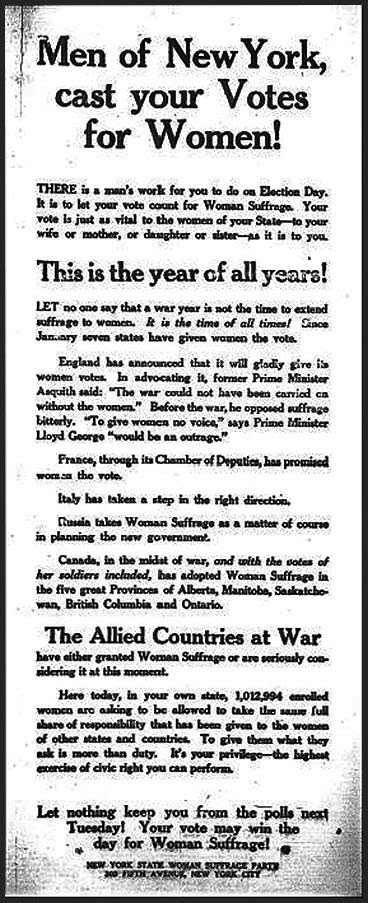

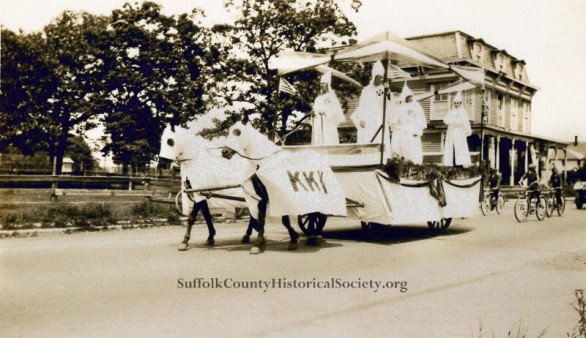
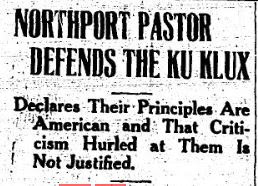 Front Page Article Title in the County Review of August 10, 1923.
Front Page Article Title in the County Review of August 10, 1923.